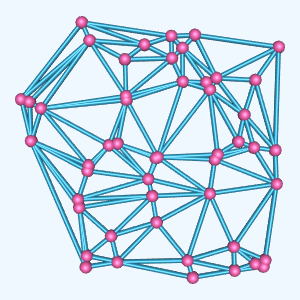DelaunayMesh
Repository source: DelaunayMesh
Description¶
This is two dimensional Delaunay triangulation of a random set of points. Points and edges are shown highlited with spheres and tubes.
Info
See Figure 9-54 in Chapter 9 The VTK Textbook.
Other languages
See (Cxx), (Python), (PythonicAPI)
Question
If you have a question about this example, please use the VTK Discourse Forum
Code¶
DelaunayMesh.java
import vtk.vtkNativeLibrary;
import vtk.vtkRenderWindow;
import vtk.vtkRenderWindowInteractor;
import vtk.vtkRenderer;
import vtk.vtkActor;
import vtk.vtkNamedColors;
import vtk.vtkPolyDataMapper;
import vtk.vtkPoints;
import vtk.vtkMinimalStandardRandomSequence;
import vtk.vtkPolyData;
import vtk.vtkDelaunay2D;
import vtk.vtkExtractEdges;
import vtk.vtkTubeFilter;
import vtk.vtkGlyph3D;
import vtk.vtkSphereSource;
public class DelaunayMesh
{
// -----------------------------------------------------------------
// Load VTK library and print which library was not properly loaded
static
{
if (!vtkNativeLibrary.LoadAllNativeLibraries())
{
for (vtkNativeLibrary lib : vtkNativeLibrary.values())
{
if (!lib.IsLoaded())
{
System.out.println(lib.GetLibraryName() + " not loaded");
}
}
}
vtkNativeLibrary.DisableOutputWindow(null);
}
// -----------------------------------------------------------------
public static void main(String args[])
{
vtkNamedColors Color = new vtkNamedColors();
//For mesh Actor Color
double meshActorColor[] = new double[4];
//For edge Actor Color
double edgeActorColor[] = new double[4];
//For ball Actor Color
double ballActorColor[] = new double[4];
//Renderer Background Color
double BgColor[] = new double[4];
//Change Color Name to Use your own Color for Change mesh Actor Color
Color.GetColor("MidnightBlue",meshActorColor);
//Change Color Name to Use your own Color for Change edge Actor Color
Color.GetColor("Peacock",edgeActorColor);
//Change Color Name to Use your own Color for Change ball Actor Color
Color.GetColor("hot_pink",ballActorColor);
//Change Color Name to Use your own Color for Renderer Background
Color.GetColor("AliceBlue",BgColor);
//Generate some "random" points.
vtkPoints points = new vtkPoints();
vtkMinimalStandardRandomSequence randomSequence = new vtkMinimalStandardRandomSequence();
randomSequence.SetSeed(1);
double p1;
double p2;
for (int i = 0; i < 50; ++i)
{
p1 = randomSequence.GetValue();
randomSequence.Next();
p2 = randomSequence.GetValue();
randomSequence.Next();
points.InsertPoint(i, p1, p2, 0.0);
}
//Create a polydata with the points we just created.
vtkPolyData profile = new vtkPolyData();
profile.SetPoints(points);
//Perform a 2D Delaunay triangulation on them.
vtkDelaunay2D delny = new vtkDelaunay2D();
delny.SetInputData(profile);
delny.SetTolerance(0.001);
vtkPolyDataMapper mapMesh = new vtkPolyDataMapper();
mapMesh.SetInputConnection(delny.GetOutputPort());
vtkActor meshActor = new vtkActor();
meshActor.SetMapper(mapMesh);
meshActor.GetProperty().SetColor(meshActorColor);
// We will now create a nice looking mesh by wrapping the edges in tubes,
// and putting fat spheres at the points.
vtkExtractEdges extract = new vtkExtractEdges();
extract.SetInputConnection(delny.GetOutputPort());
vtkTubeFilter tubes = new vtkTubeFilter();
tubes.SetInputConnection(extract.GetOutputPort());
tubes.SetRadius(0.01);
tubes.SetNumberOfSides(6);
vtkPolyDataMapper mapEdges = new vtkPolyDataMapper();
mapEdges.SetInputConnection(tubes.GetOutputPort());
vtkActor edgeActor = new vtkActor();
edgeActor.SetMapper(mapEdges);
edgeActor.GetProperty().SetColor(edgeActorColor);
edgeActor.GetProperty().SetSpecularColor(1, 1, 1);
edgeActor.GetProperty().SetSpecular(0.3);
edgeActor.GetProperty().SetSpecularPower(20);
edgeActor.GetProperty().SetAmbient(0.2);
edgeActor.GetProperty().SetDiffuse(0.8);
vtkSphereSource ball = new vtkSphereSource();
ball.SetRadius(0.025);
ball.SetThetaResolution(12);
ball.SetPhiResolution(12);
vtkGlyph3D balls = new vtkGlyph3D();
balls.SetInputConnection(delny.GetOutputPort());
balls.SetSourceConnection(ball.GetOutputPort());
vtkPolyDataMapper mapBalls = new vtkPolyDataMapper();
mapBalls.SetInputConnection(balls.GetOutputPort());
vtkActor ballActor = new vtkActor();
ballActor.SetMapper(mapBalls);
ballActor.GetProperty().SetColor(ballActorColor);
ballActor.GetProperty().SetSpecularColor(1, 1, 1);
ballActor.GetProperty().SetSpecular(0.3);
ballActor.GetProperty().SetSpecularPower(20);
ballActor.GetProperty().SetAmbient(0.2);
ballActor.GetProperty().SetDiffuse(0.8);
// Create the renderer, render window and interactor.
vtkRenderer ren = new vtkRenderer();
vtkRenderWindow renWin = new vtkRenderWindow();
renWin.AddRenderer(ren);
vtkRenderWindowInteractor iren = new vtkRenderWindowInteractor();
iren.SetRenderWindow(renWin);
ren.AddActor(ballActor);
ren.AddActor(edgeActor);
ren.ResetCamera();
ren.GetActiveCamera().Zoom(1.3);
ren.SetBackground(BgColor);
renWin.SetSize(300,300);
renWin.Render();
iren.Initialize();
iren.Start();
}
}
